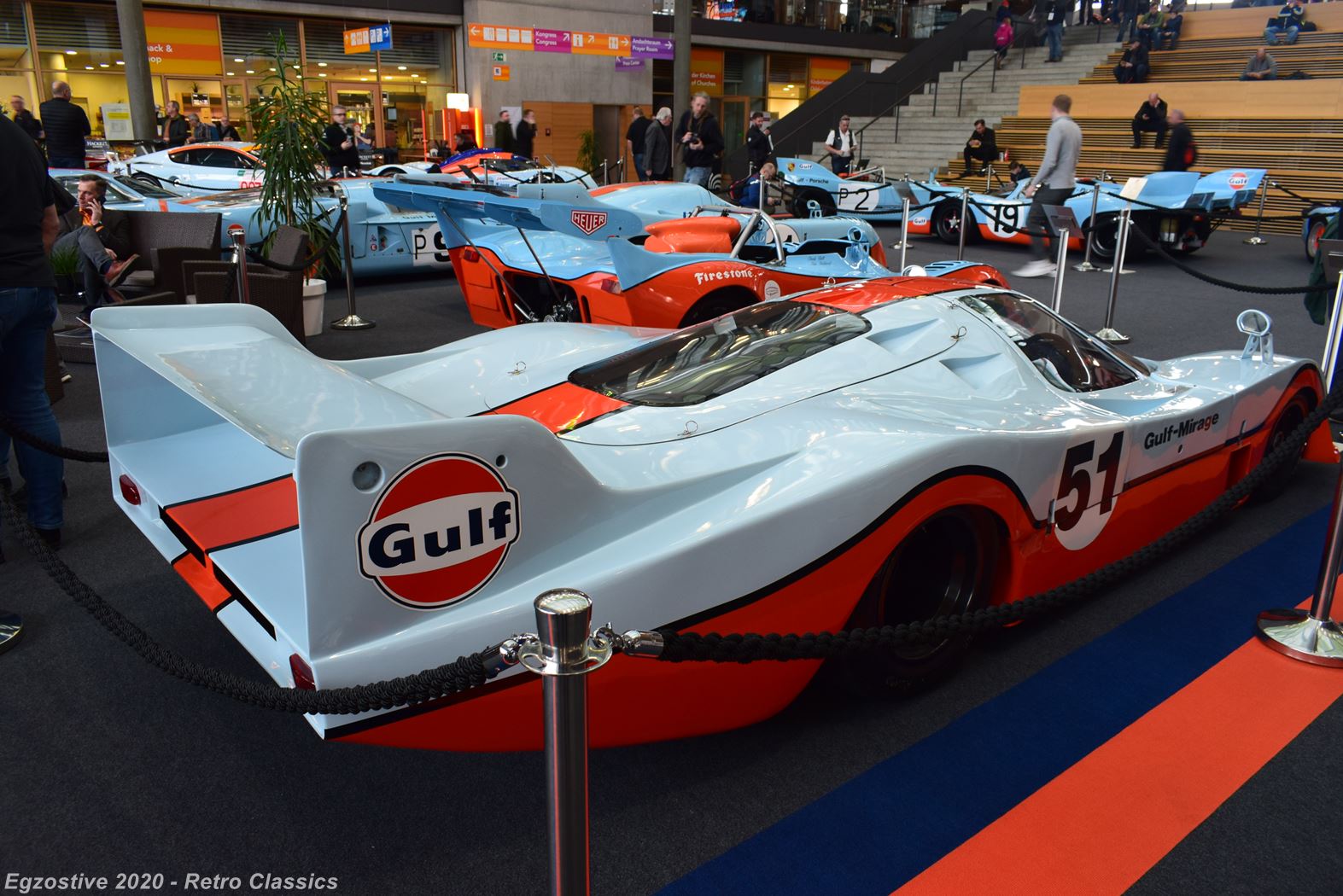The crown jewel of the Retro Classics 2020 was arguably the special stage exhibiting two dozens of legendary race cars from the ROFGO Collection in the iconic Gulf livery.

Racing driver, entrepreneur and Gulf motor racing sports fan Roald F. Goethe laid the foundations in 2008 for his ROFGO Gulf Heritage Collection. His fleet now comprises around forty vehicles from the motor racing history of the American oil giant. More than half of these vehicles can be seen in a unique show during this year’s Retro Classics.

Mr Goethe was fascinated by the successes of the Gulf JW Automotive Team in the sports car world championships during the 1968 and 1969 seasons. The Collection was compiled to preserve this extraordinary legacy. Everything started with the purchase of a Ford GT40. This classic collectable was the answer by Henry Ford II to the failed takeover of the Italian carmaker Ferrari. The legendary race war was also eternalised by the 2019 movie Ford V Ferrari crowned by two Oscars.
The Collection is resident in the UK and is accompanied by a very informative website, that features useful information on each car, that proved to be most helpful for this article. Below I will present my five personal favourites with details on the vehicles presented on the ROFGO website (with much-much more info, I highly recommend to visit the Collection’s website).
The 1970 PORSCHE 917 with CHASSIS nr 026 (031/026)
Arguably the most legendary car of the Collection is the 917, a race car that was born out of the creative interpretation of FIA’s rules.
In 1968, a new group four was also introduced, allowing cars to have engines up to 5 litres as long as they were homologated. In 1968, Porsche took a flat-8 908 engine and basically added four more cylinders, making the 4.5-litre flat-12. The chassis was also based on that of the 908.
The most successful of the 917s used by Gulf-JWAE was chassis 026. It was built in 1969 and had been as a test car before being converted to a short-tail specification for JWAE to race in 1970. The 917 was returned to Porsche and was rebuilt using chassis 031 before resuming its career with JWAE.
The 1997 McLaren GTR F1 Longtail with chassis nr 22R
The 1997 F1 opens the line on the left flank, recalling when Gulf decided to reintroduce its livery into GT racing for 1995.
While Gulf had been running the Kremer Porsche, British gentleman driver Ray Bellm had persuaded McLaren Cars to build a racing version of the F1 road car. Also with the livery of Gulf, they finished as leading runners in 1995 and 1996, winning the title in 1996.
For 1997, McLaren designed a revised car, known as the ‘long tail’ GTR to compete with the new racecars developed by Mercedes. That is the story of the longtail in a nutshell, but the ROFGO website contains much more information.
The 1968 Ford GT40 with chassis P1084
The GT40 was born out of a decision made by Henry Ford in 1962 to avenge the decision of Enzo Ferrari to reject Ford’s takeover bid. Ford initially targeted the Indianapolis “500”.
Still, towards the end of the year, Roy Lunn, the English born head of the Ford Advanced Vehicle centre, was commissioned to design a sports car For the Grand Touring Prototype Cars class.
For 1965, the GT40s were passed on to Shelby-American who fitted their 289 ci (4736cc) iron block wet-stump Ford Fairlane engine. One of the new cars built for 1965 was chassis P/1004, that was built up by JWA into a new vehicle numbered P/1084.
The 1973 McLaren M23/4 Formula 1 race car
In 1973 McLaren combined the monocoque of the 1972 Indy 500 winning M16B and the suspension of the M19 F1 racer to create one of the most successful F1 cars ever constructed. Responsible for the overall design was Gordon Coppuck.
Livered in Yardley colours, the M23 made its debut in the third race of the 1973 reason to finish third in the constructor’s championship behind champions Lotus and Tyrrell.
Following several changes, the car was restored to the 1974 colours and configuration, and in the mid-2010s restored to the 1973 Yardley livery and configuration. Now part of the ROFGO Collection, it was raced to second by Stuart Hall in the 2018 Monaco Historic Grand Prix.
The 2009 Aston Martin R16 LMP1 with chassis nr DBR1-2/2 – B09-62
The first Aston Martin prototype race car for two decades was based on a Lola B09/60 LMP1 design of 2008. However, the name of the 2009 car was always a topic of some debate, and it was also known as the Aston Martin DBR1-2, which was a direct nod to Aston Martin’s Le Mans history. The DBR1 that won Le Mans in 1959 in the hands of Roy Salvador and Carroll Shelby – Aston’s only win in the classic race epoch to date – was DBR1 chassis number 2.
Running in Gulf livery and as number 009 in a nod the James Bond / Aston Martin heritage, the car debuted at the Spa 1000kms in 2009 where Darren Turner and paying drivers Harold Primat and Miguel Ramos brought it home fifth, albeit a long way adrift of the rapid diesel Peugeots and Audis.
Following the 2010 season, the car then headed to America. It was bought by the Muscle Milk Aston Martin Racing team of Greg Pickett for the 2011 American Le Mans Series.
For more information and links to all the show-related reports on Retro Classics, please visit:
FOR AN OVERVIEW OF EVENTS, CHECK OUT MY ULTIMATE AUTOMOTIVE EVENTS CALENDAR:
The ultimate car show and automotive events calendar 2020 – The Coronavirus update December


A round of applause for your blog post. Much thanks again. Really Great!
Comments are closed.